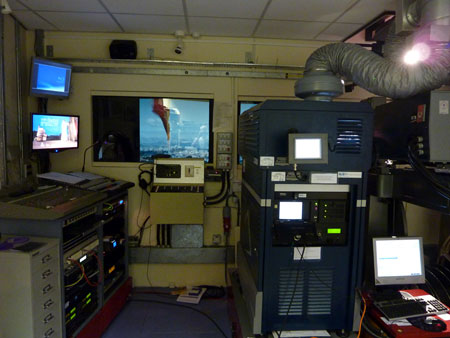Digital cinema, distribution and exhibition
The current film distribution system dates back a hundred years. In the beginning, film prints used to be sold to cinema owners who played them in various cinemas until they wore out. Gradually, the idea of a ‘film exchange’ through which films could be rented for much shorter periods developed from around 1911 onwards.
In the UK, new films generally open on a Friday. The busiest days in the cinema are Friday, Saturday and Sunday. Monday is the weakest day for the box office and Wednesday is boosted by schemes like the ‘Orange Wednesday’ programme, sponsored by the mobile telephone company. In a multiplex, new films go onto the bigger screens displacing last week’s films which move to smaller screens. Occasionally, specialised films occupy smaller screens and some films stay in the multiplex for several weeks. This in itself was an innovation in the late 1980s.
The opening ‘three day weekend’ is exploited via heavy advertising and promotion to bring in the largest audiences and it certainly still works with the 15-25 audience. But older cinemagoers (who, in the UK, offer the main opportunity for expanding the audience because they visit the cinema so infrequently) often prefer midweek nights and matinees (morning or afternoon). The industry model struggles to cope with this idea and the box-office charts ignore it. Certain films, especially dramas and costume pictures such as Atonement (UK 2007), might do good business in midweek which is not reflected in the chart position.
The current ‘theatrical’ model doesn’t work in many ways. Why run the same film for seven days if the cinema is virtually empty for four of them? Would there be audiences for different kinds of films (revivals, foreign language films, children’s films, documentaries etc.) at other times during the week? Unfortunately the bookings policies of the cinema chains and the distributors make this difficult for all but a relatively small number of specialised cinemas.

Installing and setting up the digital projector, photo by Duncan McGregor/National Media Museum
For a few years now, one way of developing a new distribution model has been promoted – the switch to digital projection. The UK has installed more digital projectors in cinemas than some other film territories – largely as the result of a UK Film Council investment scheme related to the Digital Screen Network (DSN). Although it hasn’t perhaps had quite the anticipated impact just yet, this scheme has changed some practices.
What digital projection offers
A standard digital film print arrives at the cinema on a portable hard drive the size of a small attache case and holding a data file of around 150-200gb. The projectionist uploads the print onto the digital projector and, if the cinema uses ‘automatic’ projection procedures, constructs a menu for the film’s projection (including perhaps opening curtains, masking, trailers and ads etc.) There will also be a digital key (a KDM or key display manager) to unlock the print for screening.
Once loaded, the film could stay on the projector for several weeks, being projected as and when appropriate (i.e. according to the deal with the distributor). The projector system’s server or hard drive can store a minimum of 1.5 terrabytes. The portable hard drive could then be sent on somewhere else.
The print won’t deteriorate through usage whereas celluloid prints wear each time they are projected and are often destroyed at the end of a long run in cinemas because they have developed so many scratches – often because of incorrect handling. The projectionist no longer risks back injury from handling several large and heavy reels in preparing a film for projection – but it still takes up to 4 hours to load, write a show list and test a digital print (depending on the size of the digital file).
Digital prints are cheaper to duplicate than celluloid prints (which cost around £1,000 each) and this should mean that more digital copies of smaller specialised films can be made available to cinemas at roughly the same time. So perhaps 40 or 50 small cinemas could receive a digital film copy in the same week rather than 10 celluloid prints taking a month to reach all the cinemas. In this way, smaller cinemas could benefit from advertising and promotion at the start of a film’s cinema window. At present the promotion only helps films released in London – weeks later when a film reaches smaller cinemas outside the capital, the impact of promotion is much less.
The different handling arrangements via keys also means that ‘occasional shows’ rather than a full week become possible. Digital projectors of cinema quality are now becoming available for mobile touring circuits as well.

Digital projection during the 2010 Bradford International Film Festival, photo by Duncan McGregor/National Media Museum
The second benefit of digital projection is that it can be used for other forms of entertainment. Sporting events, opera and ballet performances, music shows and interviews with directors and stars can be beamed by satellite feed providing an important alternative source of income for cinemas. Such screenings may bring a different clientele to the cinema – one used to paying for ‘exclusive’ access to major events.
Thanks to Duncan McGregor, Projection Team Manager at the National Media Museum, Bradford for invaluable help in preparing this material and for providing the images of the projector.